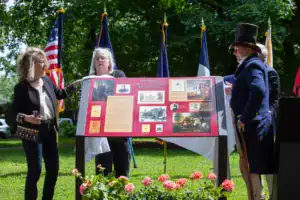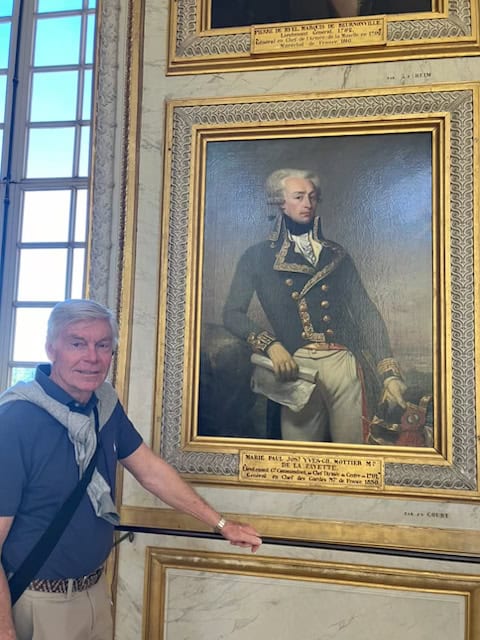 You likely first heard his name when studying the American Revolution back in your earliest school days. It is estimated that thirty-six cities and towns across America are named after him, along with a local high school. He even visited Lexington two hundred years ago, an event that was recently immortalized via a recently unveiled interpretive sign in Gratz Park.
You likely first heard his name when studying the American Revolution back in your earliest school days. It is estimated that thirty-six cities and towns across America are named after him, along with a local high school. He even visited Lexington two hundred years ago, an event that was recently immortalized via a recently unveiled interpretive sign in Gratz Park.
So, who exactly was Gilbert du Motier, better know to us as the Marquis de Lafayette/
To answer that question, Rotarians will today hear from Dale Henley, past President of the Lafayette Chapter, Sons of the American Revolution, in Lexington, and a member of the Society, American Friends of LaFayette.
Dale is a French instructor in the Osher Lifelong Learning Institute at the University of Kentucky, and has a special interest in French General Lafayette’s significant participation in America’s War of Independence.
Our speaker is a member of the Kentucky Bar Association’s Ethics Committee and an Ethics Hotline Lawyer. He is a graduate of the University of Kentucky College of Law and formerly General Counsel for East Kentucky Power where he worked for thirty years. After retirement, he was adjunct faculty at the University of Kentucky College of Law for five years, and earned a Masters degree in French from the University of Louisville in 2010.
Mr. Henley is a Vietnam War veteran (thank you for your service!) and retired Navy Commander. His naval service includes serving as Assistant Naval Attaché in the US Embassy in Rabat, Morocco.
The aforementioned Gratz Park unveiling and related celebration activities were organized by Mr. Henley and included a reenactor portraying the Marquis. The new sign, which features photos of several items related to Lafayette’s visit, states, “General Lafayette was dedicated to the principles of liberty, equality, and human rights. He was not only a hero of the American Revolution but also a lifelong advocate for abolitionism, religious freedom and women’s equality.”
Rotarians, please give our speaker a warm Rotary welcome! Or, as the Marquis himself might have proffered, bonjour monsieur!
Rotary in Review
A FRENCH HERO’S ENDURING AMERICAN LEGACY
If you grew up in the United States, there’s a good chance you first encountered the name “Marquis de Lafayette” in a grade school history lesson. His legacy, however, extends far beyond textbooks. Cities and towns across America, including thirty-six that bear his name, high schools, streets, and even parks have been named in his honor. And two centuries ago, this French general and staunch advocate for liberty made a personal visit to Lexington, Kentucky.
Last week’s guest speaker, Dale Henley, is a past president of the Lafayette Chapter, Sons of the American Revolution, a member of the Society of American Friends of Lafayette, a retired Navy Commander, attorney, French instructor, and dedicated student of Lafayette’s life and influence. Henley was a driving force behind last year’s bicentennial celebration of Lafayette’s 1825 visit to Lexington, culminating in the unveiling of a historic marker in Gratz Park, the very spot where Lafayette was welcomed by the president of Transylvania University.
Henley’s presentation transported Rotarians to that moment in history, describing the two-day celebration he helped organize, which included a convocation at Lafayette High School and the launch of a student exchange program with a sister school in Châteauroux, France. The event drew notable guests, including Lafayette’s 7th great-granddaughter (descended through his only son, George Washington Lafayette), the French consul, and descendants of Kentuckians who met Lafayette during his American tour.
The celebration’s culminating dinner at Embassy Suites was the largest single bicentennial event honoring Lafayette held anywhere in the U.S., drawing 300 attendees. “It was worth every moment of planning,” Henley said.
Henley also spoke about Lafayette’s final resting place, a small private cemetery in Paris called Picpus, where Lafayette lies beside his wife. The cemetery holds a mass grave for victims of the French Revolution’s guillotine, including his wife’s mother, sister, and grandmother, and is open only to descendants of those victims.
Lafayette’s connection to America’s military legacy stretches beyond the 18th century. In 1917, upon arriving in France with American forces during World War I, General John J. Pershing visited Lafayette’s tomb and uttered the now-famous words: “Lafayette, we are here.” Henley had the rare honor of standing in Pershing’s place to present a ceremonial wreath 106 years later, describing the moment as “deeply humbling.”
The presentation closed with an image of Lafayette and George Washington, “the two giants of the American Revolutionary War,” as Henley called them, captured in a statue that symbolizes not only their friendship but the enduring French-American alliance that helped secure America’s independence. “The statue of Lafayette and Washington is more than art, it’s a symbol of the French and American alliance that gave birth to the United States,” Henley noted. Their mutual respect lasted a lifetime, and their partnership was foundational to the birth of the United States.
As Henley reminded us, “Lafayette was not just a hero of the American Revolution, he was a lifelong advocate for liberty, equality, and human rights.” From Lexington’s Gratz Park to the quiet walled cemetery in Paris, his story remains one of courage, conviction, and lasting international friendship — and thanks to advocates like Dale Henley, it continues to inspire new generations.
- Dan Koett

